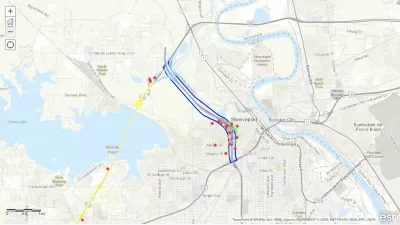According to Charles Marohn, institutional inertia continues to carry the nation's transportation agencies on a wayward path that correlates highway spending with economic development. He offers 9 principles to guide "Next Generation DOTs."
Marohn argues that the "highway building heyday" has left the nation's transportation agencies simultaneously over committed and under funded. "In reality," he says, the corellation between highway building and increased prosperity is "an illusion brought about by quick and easy development leveraged off these massive investments."
"It is the Ponzi scheme of the Suburban Experiment," he adds. "We're in the unwinding phase."
So what are the principles and understandings that America's DOTs must embody to correct course? Marohn offers the following:
- Transportation spending is not economic development.
- Transportation spending is not job creation.
- We need to budget based on what we have, not what we want to do.
- The most unsafe condition we can build is a STROAD. Our primary design goal must be to eliminate them.
- We must build differently within a city than we build outside of it.
- We need to improve travel time by eliminating access points outside of cities.
- We must stop using traffic projections to give a veneer of expertise to something we have proven incapable of doing: predicting the future.
- We need to build transit, but only through a value capture funding approach.
- We must remain humble in the face of adversity.
"The word contraction is sure to become part of this generation's lexicon," concludes Marohn, "particularly when it comes to and cities and our infrastructure systems. We need to acknowledge -- to ourselves and to society -- that we do not have a pain free solution to the contraction dilemma. In fact, our toolbox contains no solutions, just rational responses that begin with acknowledging the reality of contraction."
FULL STORY: The Next Generation DOT

Alabama: Trump Terminates Settlements for Black Communities Harmed By Raw Sewage
Trump deemed the landmark civil rights agreement “illegal DEI and environmental justice policy.”

Study: Maui’s Plan to Convert Vacation Rentals to Long-Term Housing Could Cause Nearly $1 Billion Economic Loss
The plan would reduce visitor accommodation by 25% resulting in 1,900 jobs lost.

Why Should We Subsidize Public Transportation?
Many public transit agencies face financial stress due to rising costs, declining fare revenue, and declining subsidies. Transit advocates must provide a strong business case for increasing public transit funding.

Paris Bike Boom Leads to Steep Drop in Air Pollution
The French city’s air quality has improved dramatically in the past 20 years, coinciding with a growth in cycling.

Why Housing Costs More to Build in California Than in Texas
Hard costs like labor and materials combined with ‘soft’ costs such as permitting make building in the San Francisco Bay Area almost three times as costly as in Texas cities.

San Diego County Sees a Rise in Urban Coyotes
San Diego County experiences a rise in urban coyotes, as sightings become prevalent throughout its urban neighbourhoods and surrounding areas.
Urban Design for Planners 1: Software Tools
This six-course series explores essential urban design concepts using open source software and equips planners with the tools they need to participate fully in the urban design process.
Planning for Universal Design
Learn the tools for implementing Universal Design in planning regulations.
Smith Gee Studio
Alamo Area Metropolitan Planning Organization
City of Santa Clarita
Institute for Housing and Urban Development Studies (IHS)
City of Grandview
Harvard GSD Executive Education
Toledo-Lucas County Plan Commissions
Salt Lake City
NYU Wagner Graduate School of Public Service





























